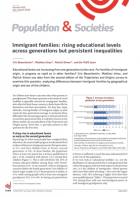
@@src2@@
When French Muslims were counted in the census
Population and Societies
n° 583, November 2020
In its counts of the population living in France, the French administration has long differentiated inhabitants according to their place of birth and their nationality. At the end of the colonial period, even though they were French, the Algerians living in metropolitan France were labelled as ‘French Muslims of Algeria’ and enumerated separately in the census. Angéline Escafré-Dublet, Lionel Kesztenbaum, and Patrick Simon explain how the government managed to identify them in the census, while pretending not to do so.




























